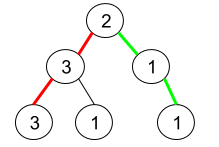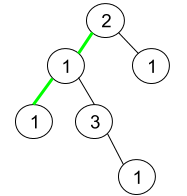Description
Given a binary tree where node values are digits from 1 to 9. A path in the binary tree is said to be pseudo-palindromic if at least one permutation of the node values in the path is a palindrome.
Return the number of pseudo-palindromic paths going from the root node to leaf nodes.
Example 1:

Input: root = [2,3,1,3,1,null,1] Output: 2 Explanation: The figure above represents the given binary tree. There are three paths going from the root node to leaf nodes: the red path [2,3,3], the green path [2,1,1], and the path [2,3,1]. Among these paths only red path and green path are pseudo-palindromic paths since the red path [2,3,3] can be rearranged in [3,2,3] (palindrome) and the green path [2,1,1] can be rearranged in [1,2,1] (palindrome).
Example 2:

Input: root = [2,1,1,1,3,null,null,null,null,null,1] Output: 1 Explanation: The figure above represents the given binary tree. There are three paths going from the root node to leaf nodes: the green path [2,1,1], the path [2,1,3,1], and the path [2,1]. Among these paths only the green path is pseudo-palindromic since [2,1,1] can be rearranged in [1,2,1] (palindrome).
Example 3:
Input: root = [9] Output: 1
Constraints:
- The number of nodes in the tree is in the range
[1, 105]. 1 <= Node.val <= 9
Code
重點都在於 if(oddCount <= 1) res++;,最多只能有一個偶數個的數字,要不然就排不成 Palindrome。剩下的只是該如何去紀錄有多少的數字是偶數個。
Use Array as Hashmap
Time Complexity: , Space Complexity:
/**
* Definition for a binary tree node.
* struct TreeNode {
* int val;
* TreeNode *left;
* TreeNode *right;
* TreeNode() : val(0), left(nullptr), right(nullptr) {}
* TreeNode(int x) : val(x), left(nullptr), right(nullptr) {}
* TreeNode(int x, TreeNode *left, TreeNode *right) : val(x), left(left), right(right) {}
* };
*/
class Solution {
int res = 0;
vector<int> count;
public:
int pseudoPalindromicPaths (TreeNode* root) {
count.resize(10);
check(root);
return res;
}
void check(TreeNode* node) {
count[node->val]++;
if(!node->left && !node->right) {
int oddCount = 0;
for(auto c: count) {
if(c % 2 == 1) oddCount++;
}
if(oddCount <= 1) res++;
} else {
if(node->left) check(node->left);
if(node->right) check(node->right);
}
count[node->val]--;
}
};BitMask
At the leaf node,
check if the count has only one bit that is 1.
int pseudoPalindromicPaths(TreeNode* root, int count = 0) {
if (!root) return 0;
count ^= 1 << (root->val - 1);
int res = pseudoPalindromicPaths(root->left, count) + pseudoPalindromicPaths(root->right, count);
if (root->left == root->right && (count & (count - 1)) == 0) res++;
return res;
}/**
* Definition for a binary tree node.
* struct TreeNode {
* int val;
* TreeNode *left;
* TreeNode *right;
* TreeNode() : val(0), left(nullptr), right(nullptr) {}
* TreeNode(int x) : val(x), left(nullptr), right(nullptr) {}
* TreeNode(int x, TreeNode *left, TreeNode *right) : val(x), left(left), right(right) {}
* };
*/
class Solution {
int res = 0;
public:
int pseudoPalindromicPaths (TreeNode* root) {
if (!root) return 0;
int count = 0;
check(root, count);
return res;
}
void check(TreeNode* node, int count) {
count ^= 1 << (node->val - 1);
if (!node->left && !node->right){
if((count & (count - 1)) == 0) res++;
} else {
if(node->left) check(node->left, count);
if(node->right) check(node->right, count);
}
count ^= 1 << (node->val - 1);
}
};